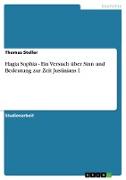Hagia Sophia - Ein Versuch über Sinn und Bedeutung zur Zeit Justinians I
BücherAngebote / Angebote:
Studienarbeit aus dem Jahr 2007 im Fachbereich Geschichte - Weltgeschichte - Frühgeschichte, Antike, Note: 1, 3, Europa-Universität Viadrina Frankfurt (Oder), Sprache: Deutsch, Abstract: The Byzantine church Hagia Sophia has been marvelled about for its size and beauty throughout many centuries. The scholarly approaches have so far been concerned mainly with the architectural history of this building. This paper constitutes an attempt to explain sense and meaning of the church in the wider context of the cultural history of the justinian time. It argues that the shape of the building not only represents a singular step in the process of the architectural development of sacral christian buildings but that it reflects upon political ideology and liturgical developments in the specific context of the empire of Byzantium. Along these lines it is perceived as a mirror of cultural dispositions of the late antiquity. The paper examines precursory buildings types which lead to the architectural design of the Hagia Sophia. It identifies the church as an ingenious hybrid of longitudinal and central building shapes. In the course of combining the two former separate types a new specific kind of space has been created. It is characterised by the increasingly intense interconnection of the religious and imperial power during the reign of Justinian I. This is observed by examining both architectural as well as functional aspects of the building. It is argued that central dome with its connotations of power and the heavenly cosmos is the pivotal point to understand the imperial signification of the building. Besides that various other architectural instruments in combination with the great dome are applied to convey an overall sense of uplifting transcendency. The church of Hagia Sophia served as the focal point of imperial religion. It functioned as the stage for the participation of the Emperor in the celebration of the Eucharist. By studying the liturgy of the church it becomes clear that the emperor took on an exalted position which added to his worldly authority. As such the Hagia Sophia symbolised the symbiotic relationship of worldly and religious power. Furthermore it is demonstrated that emperor played the dominant role in religious and tried to present himself ruling under Gods guidance and with his authority. By its pure size and elaborate decoration it confirmed the power and the self-confidence of the Justinian Empire. The Hagia Sophia is thus one places where it became manifest that Justinian clearly raised the claim to continue the roman legacy and maybe surpass it
Folgt in ca. 10 Arbeitstagen




